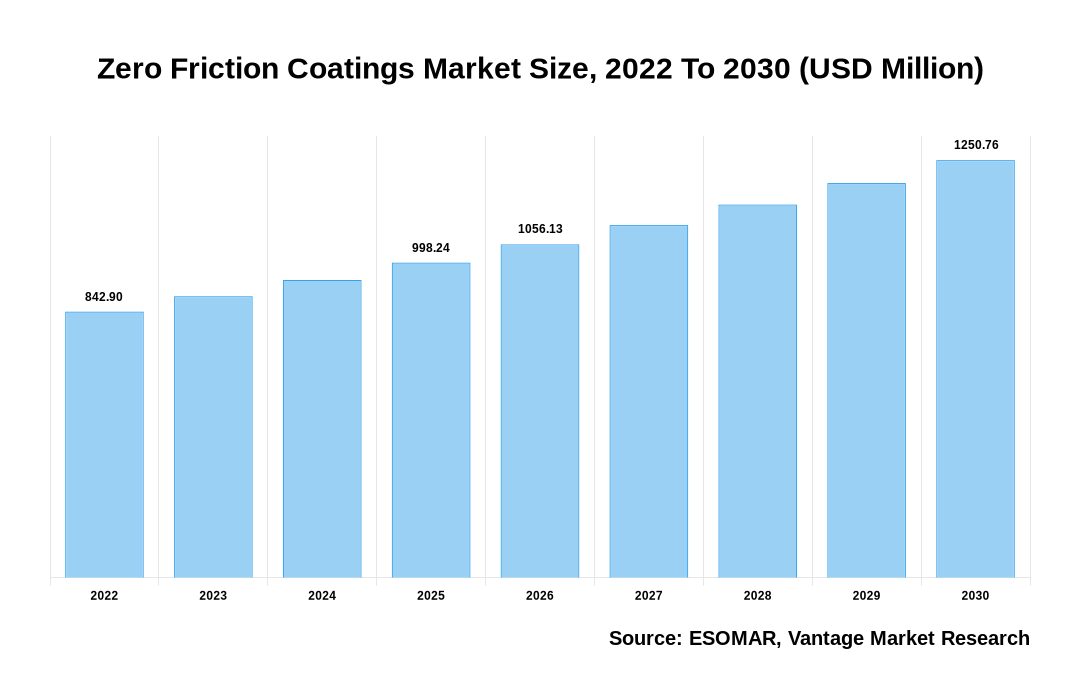Global Zero Friction Coatings Market
As stated in our extensive report; the Global Zero Friction Coatings Market accounted for USD 842.9 Million in the year 2022 and is forecast to reach USD 1250.76 Million by 2030 at a CAGR of 5.8%.
The main drivers of the growth of the Zero Friction Coatings market are the rising application of Zero Friction Coatings due to the increased desire for improved user experiences, rising rigorous government rules favoring market demand, and rising demand for medical device coatings.
Since lifelong service confidence and zero tolerance for failure are priorities, wear-resistant plastic seals are employed in specific automobile applications. Its demand is likely to be driven over the forecasted period by increasing demand from the automobile industry worldwide for a number of applications, including fuel pumps, automatic gearboxes, oil pumps, braking systems, and others.
Click To Get a Free Sample On the Research Study

Extreme conditions with high pressure, high temperatures, and vacuums can be employed with low-friction coatings. In situations requiring chemicals, heat, or clean room conditions, these coatings can improve service life and performance and do away with the requirement for wet lubricants. Products without molybdenum disulfide (MoS2) are acceptable for non-reinforced polymers whereas those with MoS2 are suitable for reinforced plastics.
In order to create Zero Friction Coatings, solid lubricant particles smaller than a micron are dispersed into resin mixtures and solvents to form paint-like solutions. It is possible to apply the substance using traditional painting techniques like brushing, dipping, and spraying. The thickness of the coating has a big impact on how well the product resists corrosion, has a low coefficient of friction, and lasts for a long time. Its thickness must be greater than the roughness of the mated surfaces’ surfaces.
Because of the rising need for coatings for medical devices and the growth and expansion of the healthcare sector, the market for Zero Friction Coatings will experience profitable growth. Growing industrialization and manufacturers’ increased focus on developing cutting-edge and efficient coatings will lead to an increase in the market for Zero Friction Coatings globally.
Key factors influencing Zero Friction Coatings Market Growth
- The increasing demand for Zero Friction Coatings is related to their lubricating and corrosion protection qualities, which lengthen a component’s wear life in sectors like automotive, energy, and aerospace.
- Over the projected period, it is anticipated that Zero Friction Coatings’ characteristics including resistance to radiation and vacuum, dust-free, dry lubrication, non-flammability, and no oxidation would help fuel product demand.
- Due to its resistance to the majority of corrosive substances, MoS2 coating solution is utilized for essential equipment and parts and is widely employed in corrosion management.
- The product lowers operating and manufacturing costs while enhancing performance, safety, and dependability by extending lubrication intervals, reducing friction and wear, preventing component failures, and controlling wear. Typically, 10-20 m of dry film thickness is used to apply these coatings.
- Depending on the component being treated, Zero Friction Coatings may be applied by dipping, spraying, using paint drums, or even using centrifuges.
- PTFE is a superior electrical insulator because of its highly flexible and inert carbon-fluorine linkages.
Asia Pacific Region Forecast to Dominate the Global Market
Asia Pacific led the area and contributed 49% of the region’s revenue in 2021. The existence of automotive manufacturing businesses in nations like China, South Korea, and Japan is credited with the expansion. The Association of Southeast Asian States, which produced over 3.5 million automobiles in 2021, is the seventh-largest automotive manufacturing hub in the world. Some of the top automakers, including Honda, Toyota, Ford, BMW, and others, are present in the area. The region’s expanding auto sector is anticipated to increase demand for Zero Friction Coatings in the upcoming years.
China is the world’s largest market for automobiles, with domestic vehicle production estimated to exceed 35 million units by 2025, according to the International Trade Administration. From 1,246,800 in 2017 to 927,632 in 2020, the nation’s imports of motor vehicles have declined. This is likely to encourage domestic auto manufacture, which will benefit the market in the upcoming years.
Europe contributed 16.8% of global revenue in 2021 and is expected to grow at a CAGR of 5.5% over the projection period. Notwithstanding supply chain issues, the commercial production of automobiles in Europe increased by 4.9% in 2021, according to the European Automobile Manufacturers Association. With a market share of over 29.5%, the U.K. was a market leader in the export of commercial cars from the area in 2021. About 7% of the EU’s GDP is generated by the automotive industry. Soon, the region’s demand for zero-friction coatings is anticipated to increase due to the country’s expanding automotive industry. VW, Daimler, BMW, and Stellantis are just a few of the region’s top automakers.
Conclusion
Increasing Demand for Medical Devices Coatings is the Major Factors Attributable to the Growth of the Zero Friction Coatings Market.
Some of the key players in the Global Zero Friction Coatings Market include- Endura Coatings (U.S.), DuPont de Nemours Inc. (U.S.), VITRACOAT (U.S.), Poeton (UK), Bechem (Germany), ASV Multichemie Private Limited (India), GMM Coatings Private Limited (U.S.) and others.
![[Market Research Reports] – Research Google News Blog | VMR.Biz](https://www.vmr.biz/wp-content/uploads/2022/12/logo-removebg-preview.png)











